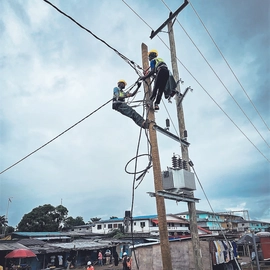(No) electricity: only one of many issues to tackle in Liberia’s capital Monrovia
September 14, 2023.
Everyday-urban life in precarious settlements in Liberia's capital Monrovia, West Africa, is characterized by risks. Like many fast-growing cities in the Global South, Monrovia's infrastructure is incomplete, especially after Liberia went through two civil wars between 1989 and 2003. After the second civil war ended in 2003, post-war Liberia has been facing the monumental task of reconstructing, restoring, and improving livelihoods. An estimated 64% of Liberians still live below the poverty line today. While the 2008 national census recorded around one million people living in Monrovia, which is one third of Liberia's population at the time, it is likely to be many more today. The city is Liberia's political, economic, and cultural center. The study presented here was conducted through in-depth empirical fieldwork in Barnesville Township in Greater Monrovia. It examines how incomplete infrastructure shapes actors' practices and influences community strategies.
Slow electricity roll-out
The Liberian civil wars damaged Monrovia's electrical infrastructure. Post-war power development and restoration projects are ongoing, but many city areas remain partially or completely cut off from the power grid. The state-owned Liberia Electricity Corporation is the sole provider of formal electrical services. Fewer than 7% of the whole country and about 22% of people in Monrovia have official access to electricity. Liberia's total installed capacity in 2022 was 126 MW, still well below the pre-war peak of 191 MW. Electricity tariffs in Liberia are among the highest in the world. Post-war electricity roll-out has been slow and characterized by delays, triggering a risk-and-possibilities landscape. Residents face the risks that illegal connections may cause, such as fire hazards, or they are forced to spend more of their meager resources on alternatives
such as generators.
New possibilities emerge
However, the situation of insufficient electricity infrastructure also creates new possibilities as it is exploited strategically by both community actors and state actors. In areas, for example, where grid connection is delayed, residents hire technicians to connect their homes. They pay for materials (cables, poles, wires, etc.), labor, and obtain official meters of Liberia Electricity Corporation through a third party. Officially, the Liberia Electricity Corporation rejects this arrangement, but they often accept these grid connections later on as legal. Thus, new patterns of community building and social interactions emerge. Sometimes those new patterns reflect existing governance problems and resource scarcity, but they can also provide practical solutions, like the unacknowledged cost-sharing between neighborhoods and the Liberia Electricity Corporation. This way, the ongoing electricity problems spur a multitude of experimentation processes that unpack options for creating community strategies and strengthen both institutional and adaptive capacities.
The power of collective action
Monrovia's story demonstrates that aside from posing challenges and limitations, incomplete infrastructure can also be productive. It can spark collective action, new commons, and new strategies. Both neighborhood-community and state actors actively shape and use incompleteness, are energized to resist, collaborate, respond, and strategize. In this sense, infrastructure incompleteness offers a landscape of risks and opportunities for all actors. The incompleteness should not be measured against the modernist norms of technical designs but as an adaptation to scarcity and possibilities.
This article is based on a paper published recently together with ZEF senior fellow Kristof Van Assche (Faculty of Science - Earth & Atmospheric Sciences,University of Alberta, Canada):
Innis, P. G., and van Assche, K. (2023). Permanent incompleteness: Slow electricity roll-out, infrastructure practices and strategy formation in Monrovia, Liberia. Energy Research & Social Science, 99, 103056. https://doi.org/10.1016/j.erss.2023.103056
Author: Phillip Innis is a junior researcher at ZEF.
Contact: s22kugre@uni-bonn.de
This article was published in ZEF News No. 47.



